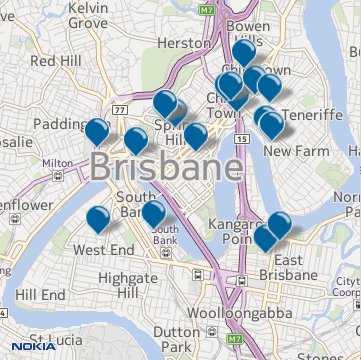Places Map (QML)

To write a QML application that will show places on a map, we start by making the following import declarations.
import QtQuick 2.0 import QtPositioning 5.2 import QtLocation 5.3
Instantiate a Plugin instance. The Plugin is effectively the backend from where places are sourced from. Because the nokia plugin has been specified, some mandatory parameters need to be filled in, see the Nokia Plugin documentation for details:
Plugin { id: myPlugin name: "nokia" //specify plugin parameters if necessary //PluginParameter {...} //PluginParameter {...} //... }
Next we instantiate a PlaceSearchModel which we can use to specify search parameters and perform a places search operation. For illustrative purposes, update() is invoked once construction of the model is complete. Typically update() would be invoked in response to a user action such as a button click.
PlaceSearchModel { id: searchModel plugin: myPlugin searchTerm: "Pizza" //Brisbane searchArea: QtPositioning.circle(QtPositioning.coordinate(-27.46778, 153.02778)) Component.onCompleted: update() }
The map is displayed by using the Map type and inside we declare the MapItemView and supply the search model and a delegate. An inline delegate has been used and we have assumed that every search result is of type PlaceSerachesult. Consequently it is assumed that we always have access to the place role, other search result types may not have a place role.
Map { id: map anchors.fill: parent plugin: myPlugin; center { latitude: -27.47 longitude: 153.025 } zoomLevel: 13 MapItemView { model: searchModel delegate: MapQuickItem { coordinate: place.location.coordinate anchorPoint.x: image.width * 0.5 anchorPoint.y: image.height sourceItem: Image { id: image source: "marker.png" } } } }
Files:
© 2015 The Qt Company Ltd. Documentation contributions included herein are the copyrights of their respective owners. The documentation provided herein is licensed under the terms of the GNU Free Documentation License version 1.3 as published by the Free Software Foundation. Qt and respective logos are trademarks of The Qt Company Ltd in Finland and/or other countries worldwide. All other trademarks are property of their respective owners.
